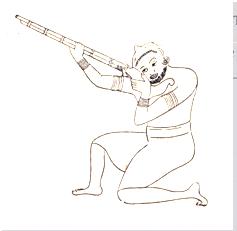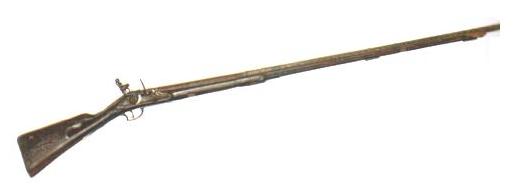Robert Knox relates of King Raja Simha II of Kandy in 17 Cent AD. that
“He took great delight in the crafts he will try his Royal Guns, and shoot at Marks, which are excellently true, and rarely inlayed with silver, Gold, and Ivory. For the Smiths that make them dare not present them to his hand, not having sufficiently proved them. He hath eight or nine small Cannon, lately taken from the Dutch, which he hath mounted in Field-Carriages, all rarely carved, and inlay’d with Silver and Brass, and Coloured Stones, set in convenient places, and painted with Images and Flowers. But the Guns disgrace the Carriages. He keeps them in an House-on the Plains. Upon some Festival times he use’th them. I think, they are are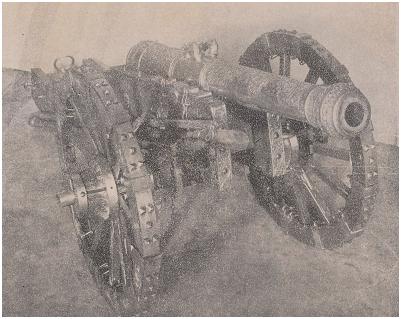 there chiefly for a Memorial of his late Victories: For he hath many, and far better Guns of Brass that are not so regarded.
there chiefly for a Memorial of his late Victories: For he hath many, and far better Guns of Brass that are not so regarded.
” In his Palace he passeth his time with looking upon certain Toyes and Fancies that he hath, and upon his arms and Guns, calling in some or other of his great Men to see the same, asking them if they have a Gun will shoot further than that: and how much Steel such a Knife, as he will shew them, needs to have in it”.
“The ran-avuda-lekam-mahatmaya, or keeper of the armoury, had charge of the royal arms, of which he kept a register, and it was his business to see that they were kept in good order by the different smiths attached to the department. Attached to this department were forty-eight young men[ Iee Vaduvo- Ieeya named after the sinhala for Arrow and Vaduvo means craftsmen]] of rank who assisted the lekam-mahatnaya “(Davy .Travels in Ceylon,p. 153).”
Read more about click on Royal Armoury
Read more about Sinhala Matchlocks
Read more about Sinhala Flintlock
Many of the figures were obtained from Kusumasiri Koddituwakku and Piyadas Welikumburain Divayina Newspaper
MUSKETS AND CANNONS.
142 AD During the Han Dynasty in China, a man named Wei Boyang was the first to write anything about gunpowder. He wrote about a mixture of three powders that would “fly and dance” violently.
There is reference to Military engines in the nature of firearms in some oldest writing of India?
1200AD Gunpowder goes West to Europe with Chinese Merchants traveling in Mongol Empire
1342 AD Siege of Algeciras the Moors by means of Thunders threw arrows exceeding great and thick so that is was much as a man could lift
1346 AD The invention of cannon preceded by a century that of small-arms, and it was by a gradual reduction in the size of the former that the latter were produced. There is speculation about earlier use of cannon but there is evidence of their use at the battle of Cressey, in 1346
1326 AD The earliest picture of a gun is in a manuscript dated showing a pear-shaped cannon firing an arrow. “De Nobilitatibus Sapientii Et Prudentiis Regum” Walter de Milemete, 1326.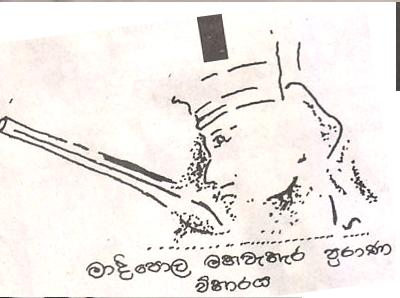
1400’s HAND GONNE – firearm [The earliest ‘hand gonne’ was developed in the fifteenth century, but was not a great influence in battle. It was a small cannon with a touch-hole for ignition. It was unsteady, required that the user prop it on a stand, brace it with one hand against his chest and use his other hand to touch a lighted match to the touch-hole. It had an effective range of only about thirty to forty yards.].
1425 AD Matchlock (“Arquebus”) introduced. Uses a “serpentine” to arc taper into the flash pan loaded with a finer grade of gun powder. Guns were fired by holding a burning wick to a “touch hole” in the barrel igniting the powder inside. [The Matchlock was a welcome improvement in the mid-fifteenth century and remained in use even into the early 1700s, when it was much cheaper to mass produce than the better classes of firearms with more sophisticated ignition systems. The Matchlock secured a lighted wick in a moveable arm which, when the trigger was depressed, was brought down against the flash pan to ignite the powder].
Figures grinding powder, priming and firing handgonnes, from a manuscript of 1410 (Codex 34, Imperial Library, Vienna)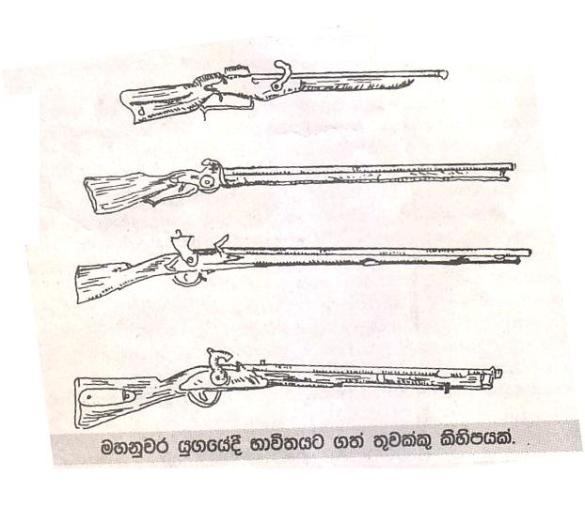
Vasco de Gama had some sort of Cannon fitted on his ship that sailed to Indian Ocean.
Wikipedia
Samoodiri (Zamorin; Malayalam: സാമൂതിരി, Portuguese: Samorim, Dutch: Samorijn) of Kozhikode is the hereditary royal title used by the Hindu rulers of the medieval Kingdom of Kozhikode on Malabar Coast (present day Kerala). The Samoodiris ruled for almost six centuries, between c. 12th and 18th century AD based at the city of Kozhikode, one of the more important trading centres in southern India.[1]
The Portuguese trader and navigator Vasco da Gama visited Kozhikode in 1498, opening the sailing route directly from Europe to India.
1502 AD Samorin of Calicut had two pieces. Following years his guns were made of Iron , but only shoot as far as man could throw stones. Portuguese Era PE Piries.
1503. Two Milanese deserters joined Samorin of Calicut and taught his people how to cast cannons.
1505 AD Four Venetians arrived in Malabar for same purpose.
1505 or 1505 AD. First mentions of Cannons
Portuguese ships arrive in Colombo’ It is reported to the King “the wear Jacket and Hats of Iron,…….. they give 2 or 3 pieces of gold and silver for a fish or one lime. The report of their Cannons is louder than thunder when it bursts upon the rock Yugandhara. There Cannon Balls fly many a Gauwa and scatters fortresses of Granite”
1512 Matchlock was introduced to India by Portuguese.[ a reserve weapon was carried by a slave- slow in loading ]
1514 AD. Moorish factory to manufacture Cannons at Diu [ Barbosa pg 60].
1517 AD Turks in Jeddah had a Basilisk which could throw a shot of three quarter of CWT.
Sep 1518 AD – A fleet of 7 Galleys and 10 Fustas laden with materials to build a fort 600 Portuguese Soldiera and 200 Nairs is sent from India to Sri Lanka , but wind drove them to Galle and they came to Colombo. They King of Kotte was received by the Portuguese Governor by a salute of his Cannons and Musketery and Trumpets
.
1520 AD King Vijeya Bahu attacks the Portuguese Stockade in Colombo. De Barros reported that several hundred guns [Espingardos], some of the caliber of a Portuguese Becos, and throwing wooden darts ten palms in length with feathers of Wild boar hide which caused damage at 200 Paces. The Sinhalese used Catapults . perhaps they fired the large stone balls from Medamaha are seen at Colombo Museum.
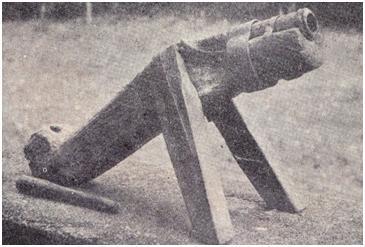
Proytela Rale advance with 2000 Foot, 150 Horses and 25 War Elephants and Portuguese withdrew. The Portuguese Matchlocks and Cannon fire from ships and pained the elephants that panicked and trampled own troops. Sinhalese army withdraws.
The type of Guns used by Portuguese were Nags, Falcons, Camels, Linns, Serpents. Basilisks, Savages, Culverins, Bombards, Pedriros, Motars, Bercos,[ Boutelho’s Lembaranca.]PE Piries Portuguese Era.
1523AD Portuguese dismantles the stockade and take back the Cannons etc.leaving behind a token force of 20 soldiers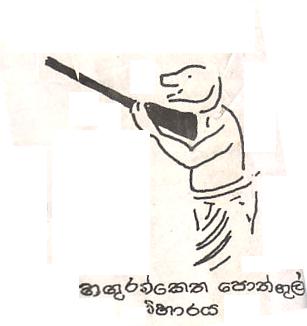
Feb 1525 . 7 Malabar ships led by Ali Hassan arrive in Colombo and burns the Portuguese ships and factory in there and demand the Portuguese in the Island. Salpuri Arachchi of Kotte with 600 troops a help the Portuguese to captures 2 ships of the Moors .
May 1525. Ali Hassan returns for revenge and by the combined Kotte and Portuguese and they 4 captured ships of Moors offered to Bhuvenake bahu by the Portuguese.[ One Galley and 2 Galliots etc].
1528 AD Samorin of Calicut send a force of 2500 troops in 15 ships sends send Mayadunna firearms and soldiers opposing Bhuvenaka Bahu and Portuguese at Kotte and Colombo. Perhaps there was Cannons on these ships. Mayadunna army advance from Sitawaka to Kotte with the arrival of Malabar ships, but withdraws with the arrival of expeditionary force in 10 ships commanded by Martim De Mello Jasrte Portuguese form Goa.
1537 AD Samorin sends a larger force of 8000 men in fifty ships under Punchi Marakar, Kunjali Marakar and Ali Abraham. Mayadunna hearing this news attack Kotte. While the Soldiers were a shore the Portugues with 650 Portuguese and many Auxiliary troops attacks the ship.

Two decades of intermittent conflict with Portuguese had taught the Sinhalese ruler the value of firearms and Sitawaka forces assisted by renegade Portuguese and some Malabar Muslims had equipped them selves with Muskets and Field Artillery.
1564 AD The Portuguese plans to attack Rajasinha of Sitawaka who is camped at Rakgahawatte , by advancing on either banks of Kelani river and bringing a Cannon Mounted on a castle built on two Padda-boats. Ragasinha is ready for them, he orders a bronze cannon be cast and mounted on the right bank and charged with ball, and as the floating Castle come into view Rajasinha himself aimed and fired the gun and with such good fortune that it raked the towing boat and killed 20 sailors. The Rajavaliya states that Rajasimha caused two field pieces mounted and fired at the Rajjahawatta at the boat called Kattala.

1578 AD. Rajasinha’s army composed of 25,000 foot, 10.000 of which were armed with Matchlocks and 600 with Kodituwakkus [ Gingle and ] 4 x Basilisks[ large cannons to break the fortifications of Colombo]] and much heavy Artillery started the siege of Colombo.
1580’s AD King Rajasimha had learn’t the value of both Artillery and Sea power during his previous abortive attempt on Colombo. He sought assistance and technical aid from both the Kunjali Admirals of Calicut and the rising new Sumatran trading power of Acheh. Gunpowder, Gunners and technicians were obtained from abroad and a strong effort made to develop a Navy.
1587-1588AD Second siege of Colombo.
1593 AD On the death of King Rajasinha the Portuguese under De Silva decided to attack Orutota which was occupied by Sitawaka force . They assembled from Negumbo Fort. And 900 Gingle were deployed by under Manaperuma Mudali decimeted the Portuguese and Dhamapala Army. During King Rajasuriya the grand son of Rajasinha of Sitawaka. Manaperuma Mohotti was is command and was enjoying aquatic sports at Orutota, when king Dharmapala of Colombo with Portuguese sent Moorish Mudali called Pida Silla[Rajavaliya] or De Sillu or De Silva to attack him. When Manaperuma heard of intended attack he arranged the his army in three ranks prepared 900 Gingals at Orutota and gave the order that no one fires until he fires the first shot.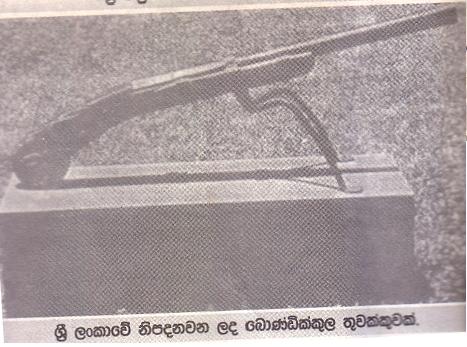
On 25 April 1593, As the Moorish Mudali and Portuguese advanced and approached the Fort, Manaperuma Mudali fired two shots and immediately the 900 pieces were discharged[ First barrage of Artillery Fire recorded in the Island], Moorish Mudali was injured . and the Sitawaka army supported by two elephants and behind their fortification and not soon after many were killed and De Silva killed his head taken as trophy to the king along with many of the Portugese who were killed, only the leader escaped with few lascarins to Colombo,
1623 AD. Construction of a Gun Powder Factory by Captain General of Colombo Constantine De Sa on the banks of the Beria lake in Colombo.
1680 AD.. The Sinhala Long Gun.Is of ).54 Caliber, Flint. Seven feet built as Sniper Gun. Available at New York Museum , known as + King of all Guns
1761 AD , To attack the fortified barrier at Matara, Galagoda needed trained battalion of gunners. From various sources he assembled different types of artillery and employed Dutch prisoners to train the Kandyans in the art of gunnery.
